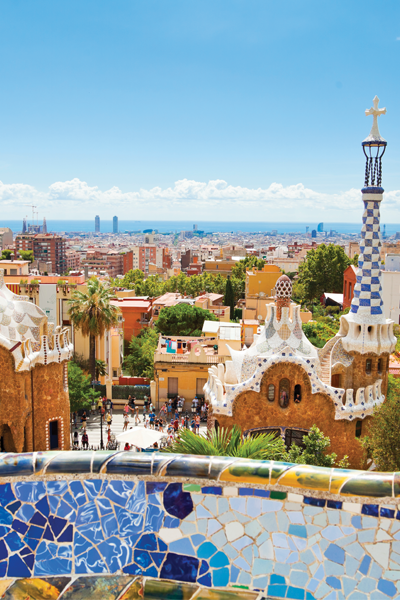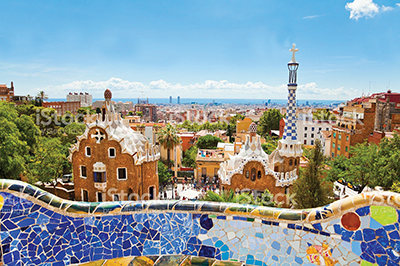
BARCELONA MOVES TO its own beat, a glorious Spanish city of art and architecture, steeped in culture and culinary cool. The resident boho-chic Catalans, distinctive for their common-sense-meets-creative-madness, fervently love their fair city, which lacks the pretention and preciousness found in some of its nearby Euro neighbors. It’s a seaside metropolis of marketplaces, medieval alleyways, modernista architecture, Michelin-starred chefs, plazas, parks, paella, and some guys named Picasso, Miró, and Gaudí. Oh yes, it’s easy to be seduced by Bar-tha-lona.
The Gothic Quarter
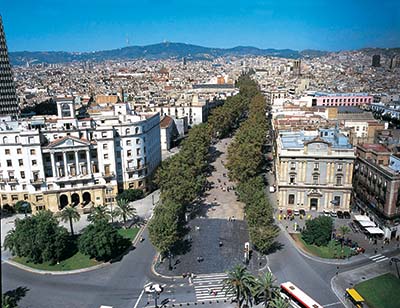
Wandering the narrow cobblestone lanes of the Barri Gòtic, you’ll discover Barcelona’s Roman roots. Once a walled city center with 2,000-year-old Roman origins, this labyrinth reveals medieval buildings, towering churches, and spectacular ruins, like the ancient Corinthian-style columns from the Roman Temple of Augustus, nearly as old as the city itself. At the 14th-century Gothic square, Plaça de Rei, the steps that fan from the palace’s corner are said to be where Queen Isabella and King Ferdinand received Christopher Columbus with his tales of the New World. And while playful schoolchildren and lunch eaters populate the plaza in the present day, envisioning Columbus regaling the royals sends a little shiver down the spine, as does peering into the darkened underbellies of the plaza’s buildings, once home to the Spanish Inquisition’s famed devices of torture.

Treasure-hunting for dragons is a favorite Gothic Quarter pastime (and a good distraction for kids underwhelmed by a walking history tour). St. George, the revered dragon-slaying knight, dominates as the patron of Catalonia, and iconography of him finishing off firebreathing beasts can be found in architectural details all over town. The ornate city hall in St. James Square offers a prime example with its elaborate St. George sculpture above its front door, but dragons also lurk in hidden corners, jut from balustrades, rest on rooftops and more. Winding streets lead to the towering Cathedral of the Holy Cross and St. Eulalia, another Gothic beauty where a lovely cloister shades a gaggle of 13 “watchdog” geese, the number representing the age of the martyred virgin for whom the cathedral is named.
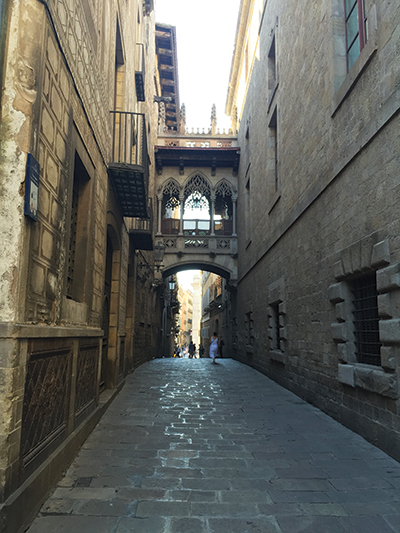
Art and Architecture
After this hearty dose of medieval history, drift over for a drink at Els Quatre Gats (Four Cats), an 1897 watering hole frequented by a young Pablo Picasso, who exhibited his early work there at the ripe age of 19. Barcelona also venerates its favorite adopted son at the Museu Picasso, where more than 3,500 pieces adorn the walls of five adjoining palaces. While much of the art reflects Picasso’s early days and Blue Period, you’ll also find some captivating Cubist paintings, ceramics, and lithographs. For an art-meets-aerial adventure, take the funicular and gondola up the mountain to Montjuïc Park, the city’s green lung and cultural hub, home to Fundació Joan Miró. This impressive paean to Joan Miró’s modern art celebrates the Catalan prodigy, whose brilliant punches of color in his surrealist paintings seemingly jump from the white walls. Knockout city and harbor views await from the rooftop as well.
But it is the genius of Antoni Gaudí that elevates Barcelona into a wonderland of unprecedented architecture, madcap design, and altered reality — from his whimsical, tile-splattered modernista buildings to his soulful magnum opus, “La Sagrada Familia.” As you stroll along splashy Passeig de Gràcia, Gaudí’s Casa Batlló will stop you dead in your tracks with the sight of the building’s marvelous mask-shaped balconies, pastel tile mosaics and serpentine roof with iridescent scales, another nod to the legend of St. George and the Dragon. The apartment complex Casa Milà (aka La Pedrera, meaning the quarry) is another arresting spectacle, with its undulating stone facade and rooftop chimneys shaped like medieval knights. In 1890, Gaudí was commissioned to design a hillside neighborhood of homes for Barcelona’s moneyed bourgeois, but the abandoned project evolved into Park Güell, a magical garden and park with two zany gingerbread-esque gatehouses with white frosting, circus tent roofs, a mosaic dragon and a colonnade of giant Dorics supporting a plaza above, which is rimmed with curvy colorful benches clad in Gaudí’s signature trencadís (broken tile bits), a nice spot for relaxing and taking in the entrancing city views.
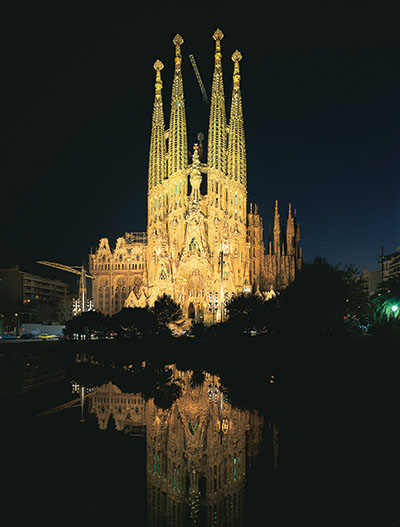
La Sagrada Familia
Gaudí spent 43 years of his life (1883–1926) fervently working on this hauntingly beautiful, still-incomplete, neo-Gothic church. The ornate exterior has a dizzying display of details and sculptures, three facades depicting the birth, passion, and glory of Jesus, and eight soaring 100-plus-meter towers (with ongoing plans for a total of 18). Entering the monumental church, you’ll understand why Gaudí was called “God’s architect,” as the maestro’s design radiates harmony and the divine. Gazing upward, the eye darts from detail to detail — parabolic arches and circular green and gold apertures in the vaults, giant columns soaring like sturdy trees with endless branches, spirals, skylights and stained glass allowing streams of colored light to transport and inspire.
The enormity of the project and its immense ethereal beauty all but send you to your knees, regardless of your faith or lack thereof. Be sure to ride the elevator up into the towers for jaw-dropping city and sea panoramas, and at minimum, take a self-guided audio tour to gain an understanding of the complexity and genius of Gaudí’s mind-bending, transcendent work. Gaudí, who died in 1926 after being hit by a tram, is buried in the crypt, but generations of craftsmen and architects continue to carry out his vision, with the La Sagrada Familia project slated to be completed around 2026.
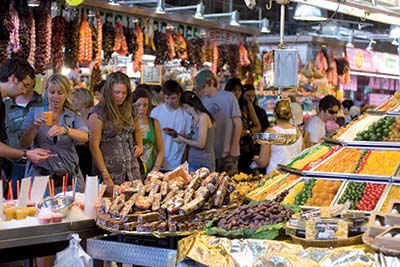
Inspired Eats
Now spiritually sated, you’re ready to explore Barcelona’s culinary scene. Venture up Las Ramblas, a tree-lined, people-parading promenade full of tourists, vendors, performance artists, painters, pickpockets, human statues, shops, tapas cafes, and other sights. Look for the Miró mosaic near the Gran Teatre del Liceu (opera house), then duck into Barcelona’s famed La Boqueria marketplace. This massive 1840’s food hall buzzes like a beehive with eye-popping displays — from rainbows of fruit, hanging hams, egg-filled hay baskets and tangles of octopus to garlic-stuffed olives, blood sausages, foraged mushrooms, fine cheese, crustaceans, and salted cod. Push through the touristy stalls and venture deeper to where the locals shop. Be sure to taste the famed ruby-hued Iberico ham or grab a coveted seat at Bar Pinotxo and savor some home-cooked authentic Catalonian baby squid with white beans in a balsamic reduction.
As Barcelona is teeming with tapas bars, endless epicurean adventures await at eateries like the tiny bodega Quimet & Quimet, for cheese plates and mussels, or Tapas 24, where elBulli alum chef Carles Abellan serves up his famed Bikini sandwich (toasted iberico ham with black truffles and mozzarella), decadent McFoie burgers or pork belly tacos jazzed with mint and yogurt. At bustling Bar Cañete, friendly waiters in snazzy white jackets with black epaulets turn service into performance art that’s as engaging as the stellar food. Humor abounds, with menus proclaiming “F*%! YOUR DIET,” which is good advice, as the cannelloni stuffed with roasted chicken in a foie béchamel is divine, as are the acorn-fed bellota ham (worth every penny), wild tuna tartare and egg-yolk flan with passion fruit.
Paella is another national dish that’s elevated Barcelona’s culinary cred. Head to the harbor and the patio of La Gavina. Nibble on blistered padrón peppers and noodle paella with cuttlefish paired with a nice rosé, and watch the mélange of passersby, from tanned jet-setters dripping with jewels to dreadlocked skateboarders with guitars. Beachfront Barraca, in the rustic fishing village of Barceloneta, is another beautiful seafood spot: try chef Xavier Pellicer’s paella with squid, fresh fish, mussels, and garlic and parsley oil or his tasty vegan version with fresh organic vegetables. And of course Barcelona is also a go-to for seekers of Michelin-starred restaurants (21 and counting), buttoned-up service, and multicourse mind-blowing meals at hot spots like the Euro-sleek Roca Moo in the Hotel Omm (Now Closed) or the two-starred Lasarte Restaurant in the newly opened Monument Hotel.
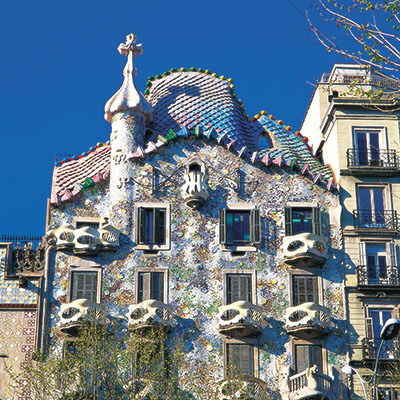
A Luxe Stay
The pearl-white Majestic Hotel and Spa, a five-star beauty, sits on prestigious Passeig de Gràcia, the city’s architectural artery and birthplace of modernisme, with work by Gaudí, Josep Puig i Cadafalch and Lluís Domènech i Montaner sprinkled along the chic street. Dapper doormen greet guests, and an impeccable staff delivers gracious service with a friendly dose of Catalonia cool within the tight formality. The smartly styled rooms invite guests to soak in a sunken marble tub or cocoon themselves in Frette linens for a comfortable snooze. But it’s the rooftop scene, La Dolce Vitae, which gives this hotel its cutting-edge panache. A DJ spins house music next to the pool, where sun worshippers lounge, sipping fish-bowl-size glasses of sangria, transfixed by the arresting views of the cityscape, sea and La Sagrada Familia, which looms majestically from this vantage point. When not poolside, head to the Majestic Spa for a Diamond Rose Ritual that uses diamond dust to exfoliate and rose-redolent lotion to hydrate the skin with the exquisite Natura Bisse line.
And for those wanting to up it yet another notch, there’s the Majestic’s “Art of Barcelona” experience: three nights in the swank Sagrada Familia Penthouse with 24/7 butler service, a private tour of the Gaudí cathedral with an architect of the project, a behind-the-scenes visit to three local art galleries, a tasting menu with wine pairings at Petit Comitè helmed by Michelin-starred chef Nandu Jubany (also the Majestic’s gastronomic adviser), plus Dom Perignon. And because you have to get there first, the package also includes Rolls-Royce rides to and from the airport.

IF YOU GO
EAT AND DRINK
Bar Cañete, Carrer de la Unió, 17 barcanete.com
Bar Pinotxo, Rambla, 91 pinotxobar.com
Barraca Passeig Marítim Barceloneta, 1 tribuwoki.com
Els Quatre Gats, Carrer de Montsió, 3 4gats.com
La Gavina, Plaça Pau Vila, 1 lagavina.es
Quimet & Quimet, Carrer del Poeta Cabanyes, 25 Tapas 24, Carrer de la Diputació, 269 tapas24.ca
STAY
Casa Furster, Passeig de Gràcia, 132 hotelescenter.es/hotel-casa-fuster
Hotel Omm, Carrer del Rosselló, 265 hotelomm.com
Majestic Hotel & Spa Passeig de Gràcia, 68 hotelmajestic.es
ART AND ARCHITECTURE
Casa Batlló Passeig de Gràcia, 43 casabatllo.es
Fundació Joan Miró Parc de Montjuïc, fmirobcn.org
La Pedrera (Casa Milà) Passeig de Gràcia, 92 lapedrera.com
La Sagrada Familia Carrer de Mallorca, 401 sagradafamilia.org
Museu Picasso Carrer Montcada, 15-23, museupicasso.bcn.cat
This article originally appeared in Marin Magazine’s print edition with the headline: “Barcelona”.

Ann Wycoff is a travel and lifestyle writer whose work has appeared in San Diego Magazine, Coastal Living, Modern Luxury, and many more. She lives in Encinitas, CA with her husband and daughter, and believes in traveling with a purpose.

